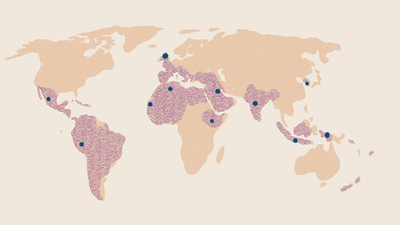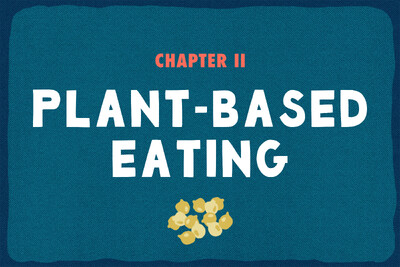Let’s be real: Plant-based cuisine in the US has an image issue.
On the one hand you have dishes—especially the types pushed in affluent neighborhoods—that are overwhelming, expensive, and sometimes even pretentious. Think: paleo breads with a vegan egg scramble. Or a nut milk-based muesli sprinkled with blue-green algae powder, goji berries, and frozen sea buckthorns. Sure, they’re beautiful and exotic. They’re also aspirational for anyone outside the immediate proximity of a trendy (read: pricey) cafe or wellness influencer’s IG feed.
On the opposite end of the spectrum, meanwhile, you have the heavily processed vegan diner food that rose to prominence in the ’90s, ushered in on a greasy wave of seitan BLTs smothered in Vegenaise and “no-chicken” chicken nuggets with cashew ranch dipping sauce. Such offerings seem hell-bent on proving that meatless meals don’t have to sacrifice taste—or apparently, comfort food decadence. Of course, the truth is that plant-based eating doesn’t have to be costly or time-consuming, require chef-level cooking skills, or clog your arteries.
And for proof, Americans just need to look beyond our own borders.

It’s a small (largely vegetarian) world after all
Mahayana Buddhists in Asia have been eschewing animal protein since the second century; many Greek Orthodox practitioners around the world, from Ethiopia to Greece, partake in over 180 days of vegetarian fasting (no meat or dairy) a year; and in India, over 20% of the population is vegetarian.
For many cultures around the world, it’s effortless. So effortless, in fact, that most people don’t think twice about it. “In Indonesia, tempeh is actually so uncool,” says Amadeus Driando Ahnan-Winarno, PhD, co-founder of the Indonesian Tempe Movement, blaming its ubiquity. There are many reasons why plant-based grains, legumes, and proteins have become staples, and they range from nutrition to cost to culinary diversity.
Why eat more veggie-based meals? Let us count the ways …
Your health
People who eat a mostly plant-based diet “have a 25% decrease in mortality from cardiovascular disease, diabetes, and certain forms of cancer,” says Desiree Nielsen, a registered dietitian and the bestselling author of Eat More Plants.
Plant-based meals ensure that your body gets the range of nutrition it needs, something it doesn’t necessarily get all the time from eating meat. “Legumes, nuts, and seeds are a critical part of ensuring [we get enough] minerals like iron, zinc, magnesium, and copper,” Nielsen says. “It’s pretty incredible what eating more plants can do.” According to studies, those on a plant-based diet have a lower prevalence of diet-related disease, with half the risk of developing diabetes compared to their omnivore counterparts, and are also less prone to heart disease.
Your wallet
According to a study by Oxford University, adopting a plant-centered diet can decrease your food costs by up to one-third.
By the numbers
$0.29/pound - Chickpeas
$1.39/pound - Black beans
$2.50/pound - Tofu
$3.72/pound - Chicken breast
$4.12/pound - Pork chops
$5.34/pound - Ground beef
The environment
We covered a lot of this in previous emails, but here are a few more eye-opening stats:
Livestock uses 100 times more land than plant-based alternatives. If everyone in the world adopted a plant-based diet, we would reduce global agricultural land use from 9.8 billion to 2.5 billion acres. Non-vegetarian diets create 59% more greenhouse gas emissions than vegetarian diets.
The protein myth
Plant-based meals often take flak for not containing enough protein. However, Nielsen says that’s a misconception. “Protein deficiency is very, very rare. What is more common is a widespread deficiency in fiber. Ninety percent of Americans do not get enough dietary fiber,” she says. Omnivores tend to eat the least fiber, while vegetarians and vegans consume significantly more without much effort, easily hitting around the recommended average of 37 grams per day. (Beans, vegetables, and fruit all contain some sort of fiber and so deficiency is less of a problem for plant-based eaters.)
Even for those who need the extra protein for bodybuilding, consuming copious amounts of meat and eggs isn’t the only way to do it. Research shows that plant-based proteins are just as efficient as animal-based proteins for building muscle.
Outside the US, plant-based cooking isn’t so complicated…
Ask a chef in New Delhi or Addis Ababa and they’ll likely tell you the same thing: The key to plant-based cooking is simple. Pick a real hearty base—whether it’s a grain, legume, fruit, or vegetable—and build on top of it.
Here are 10 core, stackable ingredients inspired by cultures around the world that are not only filling, but packed with nutrition and flavor.
This guide isn’t just intended for people who want to transition to a completely vegan or vegetarian diet; it’s for anyone who needs a bit of inspiration in the kitchen and wants to take plant-based meals out for a spin. All of these ingredients are tasty, nutritious, great for the environment, and won’t break the bank.

Step 1: Pick your base and cook it

Split pigeon peas
Also known as toor dal, split pigeon peas are a fundamental part of Indian cuisine. They are usually boiled until creamy and tender and paired with toasted spices like cinnamon or dried chilis. They’re lovely dressed over rice. “One cup of pigeon pea is 11 grams of protein and 11 grams of fiber,” says Nielsen. For context: One serving of chicken breast contains 22 grams of protein and 0 grams of fiber. So if you eat two cups of pigeon peas a day, that is both more fulfilling and nutritious compared to chicken breast.
Minimum cooking time: 30 minutes
Recipes:
Split Yellow Pigeon Peas (NYT Cooking)
Pigeon Peas With Spinach (Food52)
Where to buy: Indian specialty stores, online
Price: $0.16/ounce

Sweet potato
Unlike conventional potatoes, sweet potatoes are extremely high in vitamin A, vitamin C, and beta-carotene. From a climate perspective, they are much more versatile and can be grown anywhere from sea level to up to 9,800 feet in altitude. Sweet potatoes are ubiquitous in Latin American cuisine and can be grilled, baked, mashed, or made into fries. In Korea, they come in noodle form as well.
Minimum cooking time: 40 minutes
Recipes:
Batata Frita (Dominican Cooking)
Vegan Japchae (Okonomi Kitchen)
Where to buy: Conventional grocery stores
Price: $1.28/pound

Tempeh
A traditional protein in Indonesia, tempeh is a block of fermented soybeans that can be grilled, steamed, boiled, or fried, and marinated like it’s meat. It’s a standard building block in plant-based diets in Southeast Asia. “Compared to the average nutritional content of beef, tempeh has a similar amount of protein, energy, and iron. It’s also high in B12, which is rare in a vegan diet. You have to season it a little bit more heavily, but it absorbs flavor very well,” says Driando Ahnan-Winarno. He recommends marinating the tempeh in a sauce of choice (“Mine is usually garlic, coriander, salt, and pepper”), browning it, and then stir-frying it. It’s usually served over rice. “The fermentation helps the nutrients be more readily digestible,” he says.
Minimum cooking time: 15 minutes
Recipes:
General Tso’s Tempeh (Tasty)
Tempeh Manis (Food52)
Where to buy: Natural food stores
Price: $3.50/8 ounces

Tofu
“[Tofu] is one of the richest sources of protein and if it’s cultured with calcium, it is just as high or higher in calcium than a glass of dairy milk,” says Nielsen. And it’s a great everyday ingredient. So what are some of the best ways to cook it? “One of my meal prep ideas is to pan-fry thick slices in olive oil, well-seasoned with sea salt and black pepper,” advises Hetty McKinnon, an Australian-Chinese cookbook author and recipe developer.
Minimum cooking time: 5 minutes
Recipes:
Silken Tofu With Spicy Soy Dressing (NYT Cooking)
Sesame Tofu With Broccoli (Bon Appetit)
Where to buy: Conventional grocery stores
Price: $2/pound

Oats
Compared to other grains, oats are surprisingly high in fiber. The best ones are the stone-cut varieties, which have a lovely gritty texture. Oats don’t have to be plain and sweet. They can be packed with mushrooms or anything savory to form a complete meal. In fact, oats are so versatile that there’s an annual porridge cooking competition in Scotland centered around the ingredient.
Minimum cooking time: 20 minutes
Recipes:
English Porridge (Food52)
Savory Mushroom Oats (One Green Planet)
Where to buy: Conventional grocery stores, online
Price: $0.15/ounce

Taro
Taro is a Polynesian vegetable usually eaten for its starchy roots. The leaves are also completely edible and can be boiled down like collard greens. It’s an excellent source of fiber and helps control blood sugar. Taro can be made into fritters, a vegan patty, or fries.
Minimum cooking time: 30 minutes
Recipes:
Taro Fritters (Rhian’s Recipes)
Mashed Taro (Healthier Steps)
Where to buy: Asian or Chinese specialty stores
Price: $0.24/ounce

Chickpeas
A high-fiber legume, chickpeas are used commonly in the Middle East and the Mediterranean as an anchor staple. An incredible source of protein, they can be added into stews or turned into a hearty falafel.
Minimum cooking time: 10 minutes
Recipes:
Falafel (Downshiftology)
Lebanese Chickpea Stew (Holy Cow Vegan)
Where to buy: Conventional grocery stores, online
Price: $0.08/ounce

Teff
A traditional grain in Ethiopia, teff is packed with protein and contains all the essential amino acids the body needs. It has a similar texture to oatmeal, and it can be ground into a flour and made into injera (an Ethiopian flatbread). You can also buy it directly in flour form.
Minimum cooking time: 20 minutes
Recipes:
Teff Ethiopian-Style Stew (One Green Planet)
Injera (Maskal Teff)
Where to buy: Natural food stores, online
Price: $0.27/ounce

Plantains
A starchy banana that’s actually higher in potassium than a traditional sweet banana, the plantain is a multifaceted fruit that can be deep-fried, grilled, or mashed. A staple in Caribbean, African, and Latin American cuisine, it’s easy to prep: All you have to do is peel the plantain, slice it, and cook it.
Minimum cooking time: 15 minutes
Recipes:
Vegan Plantain Curry (Running on Real Food)
Sauteed Sweet Plantains (Allrecipes)
Where to buy: Latino specialty stores
Price: $1.29/pound

Fonio
A delicate source of complex carbohydrates from West Africa, fonio is a nutrient-packed ancient grain. “Fonio is gluten-free, rich in fibers, protein, vitamin D, calcium, iron, potassium,” says chef Pierre Thiam, who specializes in West African cuisine. “It has a neutral, slightly nutty flavor, which makes it an ideal substitute to most grains in your favorite recipes. It is a really forgiving grain that cooks in just five minutes.”
Minimum cooking time: 5 minutes
Recipes:
Jollof Fonio (Yolélé)
Turmeric Coconut Fonio (Healthier Steps)
Where to buy: Natural food stores, online
Price: $0.67/ounce

Step 2: Add-ons
Once you have your base down and cooked, feel free to layer it with add-ons.
Acid: pickles, kimchi, or just a simple squeeze of lime
Umami: mushrooms, vegan fish sauce, seaweed
Texture: crunchy vegetables, nuts
Heat: hot sauce, fresh peppers

That’s it! You’re done. It’s that easy. Bon appetit.

Hungry for more?
There are a lot of people from cultures around the world who specialize in providing plant-based inspirations. Here are some of our favorites:
If you’re still stuck, try out this handy tool we found that veganizes any recipe!

Clarissa Wei
Clarissa is a journalist based in Taipei. She is the host of Climate Cuisine, a podcast that is part of the Whetstone Radio Collective and explores how sustainable crops are used in similar climate zones around the world.
Prism asks: What’s the best thing you ate in the past month?
“Fresh bamboo shoots! Spring is the start of bamboo season in Taiwan, and I can’t get enough of it.”

Wellness stories you won’t find anywhere else.

